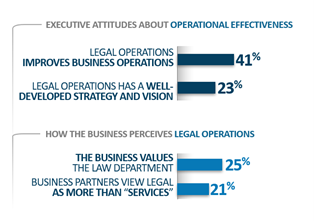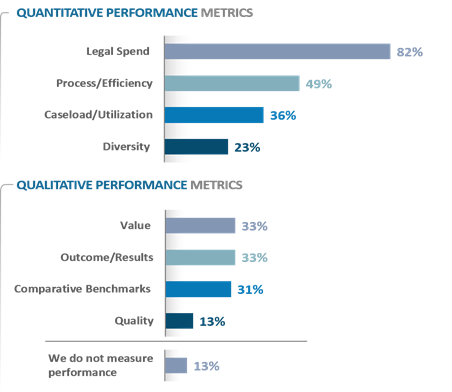
4 Steps To Set Up A Legal Ops Function For Success
As we begin to emerge from the Covid-19 pandemic, it’s clear that the lockdown afforded the opportunity for the corporate Legal Operations function to demonstrate its value as the technology-enabled ways of working it has espoused have rapidly gained traction. And yet, as our 2021 annual benchmarking study shows, this increasingly vital function is still in the early stages of maturity. Despite investments in infrastructure and longstanding efforts to improve processes, respondents still report weakness in strategic planning and unfulfilled hopes of partnership with the business.
Fig. 1 | Operational Attitudes and Sentiments

Data on operational metrics provide a clue: there’s insufficient utilization of qualitative measurement of operations performance such as quality, outcomes and value. This lack of qualitative data is significant because it substantially diminishes the quality of actionable intelligence delivered to executives for strategic decision-making. Focusing on tactical performance leads to a never-ending game of “whack-a-mole.” In essence, we know well how to measure how much we spend, but we have a way to go in understanding how well we spend it.
Fig. 2 | Legal Ops Performance Metrics

Legal Ops have yet to achieve broad operational maturity grounded in strategic planning and improvement of service quality. Based on Hyperion’s advisory work with over 250 legal departments, we’ve found that the tactical focus on Legal Ops is most often a function of status conferred on it by the GC. In departments where the head of legal operations is an executive installed as COO of the legal department, Legal Ops takes a strategic approach to operational improvement and has a transformative impact. In contrast, when Legal Ops is set up as an office administrative function, the support it provides may be appreciated but its impact is limited.
To improve the return on the investment in Legal Ops staff, we recommend selecting and empowering an executive-level lead who spearheads a collaborative strategic planning process that puts the legal department on a roadmap toward improved utilization of people, processes, technology, and data to measurably enhance the quality of legal services delivered to the corporation.
1. SET A PLACE AT THE LEADERSHIP TABLE
The head of legal operations is most effective as a change agent when included as part of the GC’s leadership team. From that vantage point, the legal COO will have visibility into the workings of the legal department; observing where there is slack and where there are constraints, and the most significant issues and challenges. Being part of the leadership team also confers professional status, especially when the initiatives they lead receive the conspicuous backing of the general counsel and the rest of the leadership team.
2. START WITH A THOROUGH ASSESSMENT DESIGNED TO ALIGN ON PRIORITIES
Typically, there is a multitude of opportunities for improvement, and a new head of legal operations often faces pressure to tackle too many at once. Taking a structured approach to assessing the state of legal operations, business needs, and external benchmarks fosters stakeholder engagement, sets up effective prioritization, and garners the information needed to make the case for new resources and processes.
The ACC Legal Operations Maturity Model provides a helpful framework to examine the current state of capabilities across 14 functions – including internal and external resources management, technology utilization, metrics and analytics capabilities, and financial controls. Legal operations staff can conduct surveys, interviews, and focus groups to achieve consensus on scores for each operational function. The head of Legal Ops can also engage an external advisor to conduct interviews with key stakeholders and provide an independent evaluation of the maturity of legal operations.
This internal assessment should be complemented by analyses of strategic business needs and levels of client satisfaction, as well as external benchmarks – especially around staffing and spending ratios. The qualitative and quantitative data gathered then becomes the baseline against which progress in advancing service quality and outcomes are measured.
With the foundation of a baseline assessment, the head of legal operations can then engage the Legal leadership team in a process to align around priorities, which in turn should be validated with key business stakeholders.
3. DRAW A ROADMAP WITH COMPREHENSIVE CHANGE IN MIND
As we have previously advised, the roadmap is a critical change management tool and should be sequenced and paced carefully to foster acceptance of new ways of working. Every organization’s roadmap will be different, but leading practices often include:
- In early stages, prioritizing initiatives that provide fuel for the long haul, such as capturing savings that support future investments, or gaining quick wins that contribute to momentum
- Ensuring the roadmap has a strategic focus on business process integration to improve cross-functional workflows, as well as integration of legal applications to improve productivity
- Improving the quality and flow of data that is generated so that dashboards can be tailored to meet different stakeholders’ needs for data-driven insights and decision-making
4. UTILIZE ACTIONABLE METRICS TO GUIDE THE MATURITY JOURNEY
The key is to consider the priorities of the business. For example, if sales velocity is critical, contracting cycle time is a key metric, as are the underlying operational performance metrics to drive continuous improvement. Where there are pressures to reduce spending, it is important to utilize metrics to understand the drivers of cost and benchmarking to understand opportunities to adjust. For example, benchmarking data can be helpful to make the case for hiring to insource certain types of legal work, adjust staffing ratios over time, or change the mix of providers handling outsourced work.
In a strategic approach to legal operations, there is a focus on Objectives and Key Results (OKRs) in addition to Key Performance Indicators (KPIs). In other words, Legal Ops matures effectively when it is focused on a few clearly defined objectives and achieves demonstrable progress by tackling no more than two or three key initiatives each year.
Learn more -> Legal Metrics that Matter On-Demand Webinar


